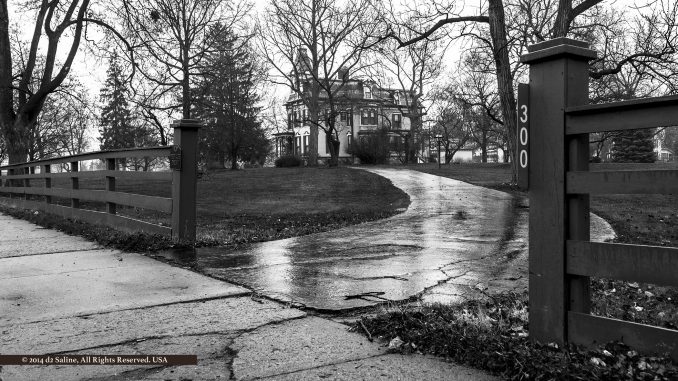
The phrase “rained out” is typically perjorative. At once it describes both a weather situation plans to be cancelled.
This needn’t be the case when eying outdoor photographs. In fact, periods just after rain has fallen will often lend added interest to subject matter, reveal otherwise hidden character, or encourage an entirely altered center of attention.
The Davenport-Curtiss House on East Michigan Avenue in Saline is one such example. Built in 1875, it remains a private residence situated on an inordinately large parcel of land in the more or less downtown corredor. As such, most photographs found on the web must have been taken from a considerable distance, leading to a pedestrian feel akin to visuals in support of real estate listings. [1]
Planning for the right time of day, keeping a patient eye out for unique weather conditions can make a world of difference — as Mike Sonnenberg proved earlier this year. [2]
The Saline Journal photograph above was made just over a week ago. A persisting true rain had just changed to a pesky mist. This inconvenience brought three special elements to the setting.
- The driveway emerged as an interesting and credibly central draw. It almost exclusively reflected and symbolized the rain. And it served as dynamic pull from sidewalk to house.
- The distractionless sky provided a blank pallet for stark, haunting tree branches. Time of day and time of year made uncertain.
- The (pale green) house had been made irredescent. In this way it could hold its own as a presence while seeming to be set to avoid being noticed.
Before considering your own efforts, remember that a top concern in rain work should be for the photographer and any accompanying persons on the site. Beyond common sense health and safety thinking, the camera position for the image above was just a few feet of an always highly trafficked US-12. [3]
A slip and fall here could literally result in death.
When it comes to process, most advice tends to focus on gear protection. Care about water and fogging on lens elements is — surprisingly — often overlooked. Screw-on filters can help, even before serving potential light modification purposes; from experience, the Sigma WR Protector series is highly recommended here. [4,5]
You may also want to revisit the Saline Journal with advice on shooting photographs under challenging snowfall conditions, published earlier this year. [6]
References
Photographed on December 23, 2014 at 10:41am using Panasonic Lumix LX100 camera with Leica 10.9-34mm DC Vario-Summilux f/1.7-2.8 lens, set to f/4 at 1/60-second and ISO 400 (hand-held).
- “Saline’s mansion” Grace Shackman (Spring 2000) Community Observer.
- “Davenport House – Michigan Historical Marker” Mike Sonnenberg (April 8, 2014) Lost In Michigan.
- “Working in the rain” (March 1, 2010) National Safety Council: Safety + Health.
- “Helpful Tips & Tricks for Taking Photos in the Rain” Christina Harman (April 14, 2014) Contrastly.
- “WR Protector Filters” Sigma.
- “‘Timing’ Is an Important Factor for Capturing Historic Photographs” Dell Deaton (January 17, 2014) Saline Journal.



